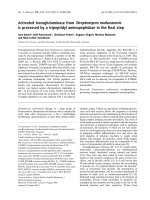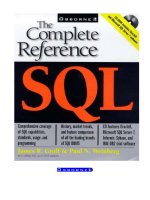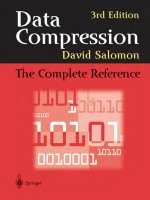Python Data Science the complete step by step python programming guide
Bạn đang xem bản rút gọn của tài liệu. Xem và tải ngay bản đầy đủ của tài liệu tại đây (1.5 MB, 55 trang )
<span class="text_page_counter">Trang 2</span><div class="page_container" data-page="2">
<i><b>PYTHON DATA SCIENCE</b></i>
<i>The Complete Step-by-Step Python Programming Guide. LearnHow to Master Big Data Analysis and Machine Learning (2022</i>
<i>Edition For Beginners)</i>
<i><b>Ivor Osborne</b></i>
</div><span class="text_page_counter">Trang 4</span><div class="page_container" data-page="4">Chapter One
Data Visualization and Matplotlib
At some point throughout your journey of dealing with all of that data and attempting to understand it, you will determine that it is time to truly view and visualize the data. Sure, we could put all of that information into a table or write it out in long, monotonous paragraphs, but it will make it difficult to focus and understand the comparisons and other information that comes with it. One of the greatest ways to do this is to take that information and, after it has been thoroughly examined, apply data visualization to make it work for our purposes.
The good news is that the Matplotlib library, which is a NumPy and SciPy extension, can assist us in creating all of them. The Matplotlib library can
</div><span class="text_page_counter">Trang 5</span><div class="page_container" data-page="5">help you visualize your data as a line graph, a pie chart, a histogram, or in another way.
When it comes to this topic, the first thing we're going to try and investigate is data visualization. We need a better understanding of what data visualization is, how it works, why we would want to utilize it, and so on. When we can put all of these pieces together, it becomes lot easier to take all of the data we've been collecting and visualize it in a way that allows us to make smart business decisions.
Data visualization is the presenting of quantitative information in a more pictorial way. In other words, data visualization may be used to transform a set of data, whether tiny or vast, into visuals that are much easier for the brain to interpret and process. It is a fairly typical event in your daily life, but you may recognize them best from graphs and charts that assist you better understand the facts. Infographics will be defined as a combination of more than one of these visualizations, as well as some additional information thrown in for good measure.
You will discover that there are numerous advantages to employing this type of data visualization. It can be used to assist with trends and facts that are unknown and may be concealed deep inside the information that you have, particularly in bigger quantities of data. These visualizations include inline charts, which show how something changes over time, column and bar charts, which allow you to make comparisons and observe the relationship between two or more objects, and pie charts, which indicate how much of a whole something takes up.
These are just a few instances of data visualization that you may come across while working.
The second thing we need to consider is what will make for good data
</div><span class="text_page_counter">Trang 6</span><div class="page_container" data-page="6">visualization. These will be built when we can combine design, data science, and communication into one. When done correctly, data visualization may provide us with vital insights into complex collections of data, and this is done in a way that makes them more relevant for those who use them, and more intuitive overall.
Many businesses will profit from this type of data visualization, and it is a tool that should not be overlooked. When you are attempting to evaluate your data and want to ensure that it matches up properly and that you fully appreciate all of the information that is being presented, it is a good idea to look at some of the plots later on and pick which ones can best talk about your data and which one you should utilize.
You may be able to extract all of the information you require from your data and complete your Data Analysis without the use of these graphics. However, if you have a large amount of data and don't want to miss anything and don't have time to look through it all, these visualizations will come in handy. The finest data visualizations will incorporate a variety of complicated ideas that can be communicated in a way that is efficient, precise, and clear, to mention a few.
To assist you in creating a good type of data visualization, ensure that your data is clean, well-sourced, and thorough. This is a step that we covered previously in the guidebook, so your data should be ready by now. When you're ready and the data is ready, it's time to look at some of the charts and plots that are available for use. This might be difficult and challenging at times depending on the type of information you are working with at the moment. You must select the chart type that appears to work best for the data you have available.
After you've done your research and determined which style of chart is best
</div><span class="text_page_counter">Trang 7</span><div class="page_container" data-page="7">for you, it's time to go through and create, as well as customize, that chosen graphic to work best for you. Keep your graphs and charts as simple as possible because these are frequently the greatest forms of graphs. You don't want to waste time throwing in components that aren't necessary and will merely distract us from the data.
The visualization should be finished at this point. You've chosen the one you want to use, after sorting and cleaning your chosen data, and then you've chosen the proper chart to use, bringing in the code that goes with it to obtain the greatest results. Now that this section is complete, it is time to take that visualization, publish it, and share it with others.
<b>Why is it important to use data visualization</b>
With that information in mind, let's take a look at some of the advantages of using data visualization and why so many people enjoy working with it. While it is possible to do the analysis and more on your own without the graphs and other visuals, this is often a poor way to make decisions and does not ensure that you understand what is going on with the data in front of you or that you see the full amount of information and trends that are presented. In addition, some of the additional reasons that data analysts prefer to work with these types of visualizations are as follows:
It assists them in making better decisions. Today, more than ever before, businesses have decided to examine a number of data tools, including data visualizations, in order to ask the appropriate questions and make the best decisions for them. Emerging computer technology and user-friendly software programs have made it a little easier to learn more about your firm and guarantee that you are making the greatest decisions for your organization, supported by solid facts.
The significant emphasis on KPIs, data dashboards, and performance
</div><span class="text_page_counter">Trang 8</span><div class="page_container" data-page="8">measurements already demonstrates the necessity of taking all of the data collected by the organization and then measuring and monitoring it. Some of the best quantitative information that a business may already be measuring right now and that they may put to good use after the analysis is the firm's market share, the expenses of each department, the revenue collected by quarter, and even the units or products that the company sells.
The next advantage of using this type of data visualization is that it can assist us in telling a tale with a lot of meaning behind it. When we look at some of the work done by the mainstream media, data visualizations and other informational visuals have become crucial tools. Data journalism is a growing industry, and many journalists rely on high-quality visualization tools to tell stories about what's going on in the world around them.
This is something that has gained traction in recent years. Many of the world's most prestigious institutions, like The Washington Post, The New York Times, CNN, and The Economist, have completely embraced the concept of data-driven news.
Marketers can also enter the scene and benefit from the combination of emotional storytelling and quality data that they have at their disposal at all times. A skilled marketer will be able to make data-driven decisions on a daily basis but communicating this information with their clients will necessitate a somewhat different strategy. This strategy must be able to appeal to both the emotional and the rational sides of the brain at the same time. You will discover that using heart and statistics, the graphics from the data may ensure that marketers are able to get their message out there.
Another factor that may influence our decision to work with this type of data visualization is data literacy. The ability to interpret and then understand data visualization has become a need in our modern environment. Because many
</div><span class="text_page_counter">Trang 9</span><div class="page_container" data-page="9">of the resources and tools associated with these graphics are widely available in our current society, it is believed that professionals, even those who are not technically savvy, will be able to look at these visuals and obtain the necessary information from them.
As a result, boosting the amount of data literacy discovered around the world will be one of the most important pillars that we will observe when it comes to a lot of data visualization companies and more. To assist individuals in business in making better decisions, it is critical to have the proper information and the correct tools, and data visualization graphs will be the key to accomplishing this. The precedence that comes with data visualization.
We might also seek assistance from Florence Nightingale in this regard. She was best renowned for her work as a nurse during the Crimean War, but she was also a data journalist known for her rose or coxcomb diagrams. These were a form of revolutionary chart that helped here to acquire better hospital conditions, which in turn helped to save many lives of the soldiers that were there.
In addition, Charles Joseph Minard is responsible for one of the most well-known data visualizations. Minard was a civil engineer from France who was well-known for his use of maps to represent numerical data. He is well known for his work on the map depicting Napoleon's Russian campaign of 1812, which depicted the tragic loss of his army while attempting to advance in Moscow, as well as parts of the retreat that ensued.
<b>Why should we use of data visualization?</b>
Before delving deeper into what the matplotlib library can do (so that we have additional ways to depict our data), let's take a look at data visualization and why we should use it in the first place. Some of the several reasons why you might wish to work with data visualization are as follows:
</div><span class="text_page_counter">Trang 10</span><div class="page_container" data-page="10">1. It can take the data you already have and make it easier for you to remember and understand it, rather than simply skimming through it and hoping it makes sense.
2. It will provide you with the capacity to identify previously unknown facts, trends, and even outliers in the data that may be valuable.
3. It makes your life easier by allowing you to rapidly and effectively visualize relationships and patterns.
4. It ensures that you can ask better questions and make the greatest judgments for your organization.
<b>What exactly is matplotlib?</b>
With the rest of the information from above in mind, we can see how critical it is to work with data visualization and to have a technique in place to assist us comprehend what is going on in all of the data that we acquired earlier. This assures that we will be ready to go and that the entire analysis will operate as expected.
However, this raises another question that we must address. We need to know what approaches we may employ to assist us in creating some of these charts and graphs, as well as the other visuals that we choose to employ. Your company most likely has a lot of data, and you want to make sure that you are not just selecting the proper type of visualization, but that you are also able to put it all together and create the right visual, which is where matplotlib comes in.
The concept behind matplotlib is that a picture is worth a thousand words. Fortunately, this type of library will not require a thousand words of code to create the graphics that you desire, but it is there to create the visuals and graphics that are required to accompany any information that you have.
Even though you can rest assured that this library will not take a thousand
</div><span class="text_page_counter">Trang 11</span><div class="page_container" data-page="11">words to use, you will discover that it is a massive library to look through, and getting the plot to behave the way that you want, as well as choosing the right kind of plot, will be something that you will need to achieve at some points through trial and error. Using one-liners to generate some of the basic graphs that come with this type of coding does not have to be difficult; but, much of the rest of the library can be intimidating at times. And it is for this reason that we will look at what matplotlib is all about and why you should consider learning it so that you can incorporate some of these graphs and visualizations into your data.
First, we must investigate why matplotlib is sometimes regarded as perplexing. Learning how to deal with this type of library can be hard at first, but this isn't to suggest that the matplotlib documentation is inadequate; there is a wealth of information available. However, there are a few obstacles that programmers may face, and some of these are as follows:
<i>1. The library that you will be able to use will be quite large. In fact, itwill comprise approximately 70,000 lines of code, and it is constantlyevolving, so this figure is likely to grow over time.</i>
<i>2. Matplotlib will be the home of more than one sort of interface, ormethod of constructing a figure, and it will be able to connect with awide range of backends. The backend will handle the entire processthat occurs when the chart is rendered, not simply the structure. Thiscan cause some issues along the way.</i>
<i>3. While this library will be quite extensive, it will be a part of NumPyand SciPy, so you should make sure you understand how to use theselanguages ahead of time to make things easier.</i>
To see how this one can operate, we need to know a little bit about its past. John D. Hunter, a neurobiologist, started working on this collection in 2003. He was initially inspired to emulate the commands found in the
</div><span class="text_page_counter">Trang 12</span><div class="page_container" data-page="12">Mathworks-supplied MATLAB software.
Hunter died in 2012, and the matplotlib library is now a collaborative effort built and maintained by a slew of others.
One of the important advantages of MATLAB is that it has a global style. The Python notion of importing is useful at times, but it will not be utilized much in MATLAB, and most of the functions that we use with this will be available to the user when they are on the top level.
Knowing that matplotlib has its origins in the MATLAB process can assist to explain why pylab exists in the first place. Pylab is a module that exists within our matplotlib library and was designed to mimic some of the global style that we can find in MATLAB. It exists solely to assist in bringing together several classes and even functions from matplotlib and NumPy to form a namespace. This will be useful for those who want to switch from the previous MATLAB without having to import the statements.
The most significant issue that did emerge here is something that some Python users may have seen in the past. Using the form pylab import in a session or a script was possible, but it was widely regarded as bad practice. In some of the lessons it has published, Matplotlib does not advise against doing this at all. Internally, there are many potentially conflicting imports that are used and masked in the short-come source, and as a result, the matplotlib library has abandoned some of the convenience that comes with this model and recommends to all users that they do not work with pylab, bringing them more in line with some of the key parts of the Python language, so that these can work better together.
The matplotlib object hierarchy is another aspect that we must consider. If you've gone through any kind of beginner's lesson on this library, you've probably used plt.plot([1, 2, 3]) or something similar. This will be an
</div><span class="text_page_counter">Trang 13</span><div class="page_container" data-page="13">excellent one to utilize on occasion, but keep in mind that this one-liner will hide the fact that the plot will be a hierarchy with Python objects nested and hidden inside. In this situation, the hierarchy will imply that there will be a structure in the objects that is similar to a trial that is hidden with each of the plots that we have.
A figure object will be the container for this type of image on the outside. Instead, we'll observe that there are numerous Axes objects that we can then use. The name of Axes can be a source of misunderstanding for us. This can result in what we perceive of as an individual graph or plot, rather than the axis that we are accustomed to seeing on a chart or graph.
Consider the Figure function that we are utilizing as a box-like container that will hold at least one, but frequently more than one, Axes or real plots. There will be a hierarchy of smaller objects behind the Axes that we see, such as text boxes, legends, individual lines, and tick marks, to mention a few, and practically all of the parts that appear in this type of chart may be changed by a Python object on its own. This will cover even the smallest details, such as labels and ticks.
The stateless and stateful approaches to matplotlib are the next things we need to look at. For the time being, we will look at the stateful interfaces, which include the state machine and the state-based, as well as the stateless, which are the object-oriented interfaces.
Almost all of the functions available in pyplot, including plt.plot(), will either refer to the existing current Figure as well as the current Axes that you worked with, or will assist you in creating a new one if none exist.
Those who have spent a significant amount of time using MATLAB before switching over may prefer to phrase the differences above as something more along the lines of plt.plot() is a state machine interface that will implicitly
</div><span class="text_page_counter">Trang 14</span><div class="page_container" data-page="14">follow the tracks of the current figures. This may not make much sense unless you have spent a significant amount of time working on programming, but it signifies the following in more common terms:
1. The standard interface that you can use will be called up with plt.plot) and other top-level functions in pyplot. Remember that there will only be one Figure or Axes that you are attempting to manipulate at any given time, and you do not need to go through and explicitly refer to it to get things done.
2. Directly modifying the underlying objects will be regarded an object-oriented approach. It is common to do this by using the calling methods with an Axes object, which can represent the plot on its own.
We can boil it all down and see how it works in just a few lines of code to help us obtain a bit more information about how this plt.pot() function is going to work because we have already spent some time talking about it in this chapter. These codes will be as follows:
</div><span class="text_page_counter">Trang 15</span><div class="page_container" data-page="15">Chapter Two Neural Networks
<b>Convolutional Neural Networks</b>
Convolutional Neural Networks (CNNs) are a type of deep neural network that has proven to be particularly effective in a variety of computer science applications such as object recognition, object categorization, and computer vision. ConvNets have been used for many years to differentiate between faces, recognize objects, and power vision in self-driving cars and robotics.
A ConvNet can recognize and provide captions for a large number of visual scenes. ConvNets may also recognize everyday items, animals, and humans. Convolutional Neural Networks have recently been employed successfully in natural language processing tasks such as sentence classification.
</div><span class="text_page_counter">Trang 16</span><div class="page_container" data-page="16">Convolutional Neural Networks are thus one of the most essential tools for machine learning and deep learning problems. LeNet was the first Convolutional Neural Network to be introduced, and it played a vital role in propelling the broader area of deep learning. Yann LeCun proposed the very first Convolutional Neural Network in 1988. It was mostly used to solve character recognition challenges like reading digits and codes.
Convolutional Neural Networks, which are widely utilized in computer science nowadays, are extremely similar to the first Convolutional Neural Network developed in 1988.
LeNet, like today's Convolutional Neural Networks, was employed for a wide range of character recognition applications. The conventional Convolutional Neural Networks that we use today, like LeNet, have four major operations: convolution, ReLU non-linearity activation functions, sub-sampling or pooling, and classification of their fully-connected layers.
These operations are the foundational steps in the construction of any Convolutional Neural Network. To go on to dealing with Convolutional Neural Networks in Python, we must first delve further into these four fundamental functions to gain a better understanding of the idea underlying Convolutional Neural Networks.
Every image, as you are aware, may be easily represented as a matrix comprising several values. We will use the usual term channel to refer to a specific component of images. An image captured by a normal camera typically contains three channels: blue, red, and green. Consider these images to be three two-dimensional matrices layered on top of each other. Each of these matrices also has unique pixel values ranging from 0 to 255.
A grayscale image, on the other hand, only has one channel because there are no colors visible, simply black and white. In this case, we'll be looking at
</div><span class="text_page_counter">Trang 17</span><div class="page_container" data-page="17">grayscale images, thus the example we're looking at is just a single-2D matrix that represents a grayscale image. Each pixel in the matrix must have a value between 0 and 255. In this situation, 0 denotes a black color while 255 denotes a white color.
<b>Convolutional Neural Networks: How Do They Work?</b>
Convolutional Neural Network structures are commonly employed to solve deep learning challenges. Because of their structure, Convolutional Neural Networks are utilized for object recognition, object segmentation, detection, and computer vision, as previously stated. CNNs learn directly from picture input, eliminating the requirement for manual feature extraction, which is prevalent in traditional deep neural networks.
The use of CNNs has grown in popularity due to three major considerations. The first is the structure of CNNs, which eliminates the requirement for manual data extraction because Convolutional Neural Networks learn all data features directly. The second reason for CNNs' growing popularity is that they generate fantastic, cutting-edge object identification results. The third argument is that CNNs can be easily retained for many new object recognition tasks to assist in the development of further deep neural networks.
A CNN can include hundreds of layers, each of which learns to detect many different aspects of picture input automatically. Furthermore, filters are usually applied to each training image at varying resolutions, thus the output of each convolved image is utilized as the input to the next convolutional layer.
The filters can also begin with extremely simple picture attributes such as edges and brightness, and as the convolutional layers proceed, they can typically enhance the complexity of those image features that describe the
</div><span class="text_page_counter">Trang 18</span><div class="page_container" data-page="18">object. As a result, filters are often applied to every training image at various resolutions, as the output of each convolved image serves as the input to the following convolutional layer.
Convolutional Neural Networks can be trained on images ranging from hundreds to thousands to millions. When working with big volumes of image data and particularly complicated network topologies, GPUs should be used because they can greatly reduce the processing time required for training a neural network model.
Once your Convolutional Neural Network model has been trained, you may utilize it in real-time applications such as object recognition, pedestrian detection in ADAS (Advanced Driver Assistance Systems), and many more.
The output layer is the final fully-connected layer in typical deep neural networks, and it represents the overall class score in every classification setting.
Because of these characteristics, typical deep neural nets are incapable of scaling to entire images. For example, in CIFAR-10, all images are 32x32x3. This means that all CIFAR-10 images have three color channels and are 32 inches wide and 32 inches tall. This suggests that the weights in a single fully-connected neural network in a first regular neural net would be 32x32x3 or 3071. This is a more difficult number to manage because those fully-connected structures are incapable of scaling to larger images.
Furthermore, you would like to have more identical neurons so that you can quickly put up more parameters. In the case of computer vision and other related problems, however, using fully-connected neurons is inefficient because your parameters will quickly lead to over-fitting of your model. As a result, Convolutional Neural Networks use the fact that their inputs are images to solve these types of deep learning challenges.
</div><span class="text_page_counter">Trang 19</span><div class="page_container" data-page="19">Convolutional Neural Networks limit visual design in a much more rational way due to their structure. Unlike a traditional deep neural network, the layers of the Convolutional Neural Network are made up of neurons that are arranged in three dimensions: depth, height, and breadth. For example, the CIFAR-10 input images form part of the input volume of all layers in a deep neural network, which has the size 32x32x3.
Instead of all layers being fully connected like in typical deep neural networks, the neurons in these levels can be connected to only a tiny part of the layer preceding it. Furthermore, the output of the final layers for CIFAR-10 would have dimensions of 1x1xCIFAR-10 because the Convolutional Neural Networks architecture would have compressed the complete image into a vector of class score arranged only along the depth dimension at the conclusion of the design.
To recapitulate, a ConvNet, unlike traditional three-layer deep neural networks, composes all of its neurons in only three dimensions. Furthermore, each layer in the Convolutional Neural Network turns the 3D input volume into a 3D output volume with varied neuron activations.
A Convolutional Neural Network is made up of layers that all have a basic API and produce a 3D output volume with a differentiable function that may or may not include neural network parameters.
A Convolutional Neural Network is made up of subsamples and convolutional layers, which are sometimes followed by fully-connected or dense layers. As you may be aware, the input of a Convolutional Neural Network is a n x n x r picture, where n denotes the height and width of the input image and r represents the total number of channels present. Convolutional Neural Networks may also have k filters referred to as kernels. When kernels are present, their q is determined, which can be the same as the
</div><span class="text_page_counter">Trang 20</span><div class="page_container" data-page="20">number of channels.
Each Convolutional Neural Network map is subsampled using max or mean pooling over p x p in a contiguous area, where p typically varies from 2 for small images to more than 5 for bigger images. Every feature map is subjected to sigmoidal non-linearity and additive bias, either after or before the subsampling layer. Following these convolutional neural layers, there may be numerous fully-connected layers, the structure of which is the same as that of ordinary multilayer neural networks.
<b>Stride and Padding</b>
Second, after setting the depth, you must additionally indicate the stride with which you slide the filter. When you have a stride of one, you can only move one pixel at a time. When you have a stride of two, you can move two pixels at a time, but this results in lower spatial volumes of output. The stride value is one by default. However, if you desire less overlap between your receptive fields, you can make larger strides, but as previously said, this will result in smaller feature maps because you are skipping over picture spots.
If you utilize larger strides but wish to keep the same dimensionality, you must use padding, which surrounds your input with zeros. You can pad with either the values on the edge or with zeros. Once you've determined the dimensionality of your feature map that corresponds to your input, you may proceed to adding pooling layers, which are typically employed in Convolutional Neural Networks to retain the size of your feature maps.
If no padding is used, your feature maps will shrink with each layer. When you wish to pad your input volume with zeros all around the border, zero-padding comes in handy. This is known as zero-zero-padding, and it is a hyperparameter. You can regulate the size of your output volumes by
</div><span class="text_page_counter">Trang 21</span><div class="page_container" data-page="21">utilizing zero-padding. The spatial size of your output volume may be simply calculated as a straightforward function of your input volume size, the convolution layers receptive field size, the stride you employed, and the amount of zero- padding you used in your Convolutional Neural Network border.
For example, if you have a 7x7 input and apply the formula to a 3x3 filter with stride 1 and pad 0, you will receive a 5x5 output. If you choose stride two, you will obtain a 3x3 output volume, and so on, using the formula where W represents the size of your input volume, F represents the receptive field size of your convolutional neural layers, S represents the stride utilized, and P indicates the amount of zero-padding you employed.
(W-F +2P)/S+1
You can quickly calculate how many neurons can fit in your Convolutional Neural Network using this formula. When possible, try to use zero- padding. For example, if your input and output dimensions are both five, you can use a zero-padding of one to generate three receptive fields. If you do not employ zero-padding in situations like these, your output volume will have a spatial dimension of 3, because 3 is the number of neurons that can fit inside your original input.
Mutual constraints are prominent in spatial arrangement hypermeters. For example, applying stride to an input size of 10 with no zero-padding and a filter size of three is impossible. As a result, your hyperparameter set will be invalid, and your Convolutional Neural Networks library will either throw an exception or zero pad the rest fully to make it fit.
Fortunately, appropriately sizing the convolutional layers so that all dimensions incorporate zero-padding can make any job easier.
<b>Parameter Sharing</b>
</div><span class="text_page_counter">Trang 22</span><div class="page_container" data-page="22">In your convolutional layers, you can use parameter sharing strategies to completely regulate the amount of parameters used. If you designate a single two-dimensional depth slice as your depth slice, you can force the neurons in each depth slice to utilize the same bias and weights. Using parameters sharing approaches, you will obtain a one-of-a-kind set of weights, one for each depth slice. As a result, you can considerably reduce the number of parameters in your ConvNet's first layer. By completing this step, all neurons in your ConvNet's depth slices will use the same settings.
In other words, every neuron in the volume will automatically compute the gradient for all of its weights during backpropagation.
However, because these computed gradients stack up across each depth slice, you only need to update a single collection of weights each depth slice. As a result, all neurons within a single depth slice will use the same weight vector. As a result, when you forward the convolutional layer pass in each depth slice, it is computed as a convolution of all neurons' weights alongside the input volume. This is why the collection of weights we acquire is referred to as a kernel or a filter, which is convolved with your input.
However, there are a few circumstances where this parameter sharing assumption is invalid. This is frequently the case with a large number of input photos to a convolutional layer with a specific centered structure, where you must learn different features based on the location of your image.
For example, if you have an input of numerous faces that have been centered in your image, you may anticipate to acquire various hair-specific or eye-specific traits that could be easily learned at many spatial places. When this occurs, it is fairly usual to simply loosen the parameter sharing strategy and employ a locally connected layer.
<b>Matrix Multiplication</b>
</div><span class="text_page_counter">Trang 23</span><div class="page_container" data-page="23">Those dot products between the local regions of the input and between the filters are usually performed by the convolution operation. In these instances, a typical convolutional layer implementation strategy is to take full use of this feature and design the specific forward pass of the primary convolutional layer as one huge matrix multiply.
Matrix multiplication is implemented when the local portions of an input image are entirely stretched out into separate columns during the im2col procedure. For example, if you have an input of size 227x227x3 and convolve it with a filter of size 11x11x3 at a stride of 4, you must stretch every block of pixels in the input into a column vector of size 363.
When you run this process in your input stride of 4, you obtain 55 locations as well as weight and height, which leads to an output matrix of x columns, where each column is a maximally stretched out receptive field and you get 3025 fields in total.
Each number in your input volume can be repeated in several columns. Also, keep in mind that the weights of the convolutional layers are similarly spread out into certain rows. For example, if you have 95 filters with dimensions of 11x11x3, you will receive a matrix with w rows with dimensions of 96x363.
In terms of matrix multiplications, the output of your convolution will be equivalent to conducting one massive matrix multiply that evaluates the dot products between every receptive field and between every filter, resulting in the output of your dot production of every filter at every position. Once you get your result, you must reshape it to the correct output dimension, which in this example is 55x55x96. This is a fantastic strategy, but it has a drawback. The biggest disadvantage is that it consumes a lot of memory because the values in your input volume are reproduced numerous times. The fundamental advantage of matrix multiplications, however, is that various
</div><span class="text_page_counter">Trang 24</span><div class="page_container" data-page="24">implementations can improve your model. Furthermore, while conducting pooling operations, this im2col can be reused several times.
</div><span class="text_page_counter">Trang 25</span><div class="page_container" data-page="25">Chapter Three Decision Trees
Decision trees are formed in the same way as support vector machines, and they are a type of supervised machine learning technique that can solve both regression and classification problems. They are effective for dealing with large amounts of data.
You must go beyond the fundamentals in order to process huge and complex datasets. Furthermore, decision trees are utilized in the construction of random forests, which are often regarded as the most powerful learning method. Because of their popularity and efficiency, we will primarily focus
</div><span class="text_page_counter">Trang 26</span><div class="page_container" data-page="26">on decision trees in this chapter.
<b>An Overview on Decision Trees</b>
Decision trees are fundamentally a tool that supports a decision that will influence all subsequent decisions. This means that everything from expected outcomes to consequences and resource utilization will be altered in some way. Take note that decision trees are typically represented in a graph, which can be thought of as a type of chart in which the training tests appear as nodes. For example, the node may be a coin flip with two possible outcomes. Furthermore, branches sprout to represent the results individually, and they have leaves that serve as class labels. You can see why this method is referred to as a decision tree now. The structure is reminiscent of a tree. Random forests are, as you might expect, exactly what they sound like. They are collections of decision trees, but that's all there is to it.
Decision trees are one of the most powerful supervised learning methods, particularly for beginners. Unlike more complex algorithms, they are relatively simple to implement and have a lot to offer. Any common data science task can be performed by a decision tree, and the results obtained at the end of the training process are highly accurate. With that in mind, let's look at a few more benefits and drawbacks to gain a better understanding of their use and implementation.
Let's start with the good news:
1. Decision trees are basic in concept and thus straightforward to execute, even if you have no formal education in data science or machine learning. This algorithm's notion can be summarized with a formula that follows a popular style of programming statement: If this, then that, otherwise that. Furthermore, the results will be very simple to interpret, thanks to the graphic depiction.
</div><span class="text_page_counter">Trang 27</span><div class="page_container" data-page="27">2. A decision tree is one of the most efficient approaches for examining and deciding the most significant factors, as well as discovering the relationship between them. You may also easily create new features to improve measurements and forecasts. Don't forget that data exploration is one of the most crucial stages of working with data, especially when there are a lot of variables to consider. To prevent a time-consuming procedure, you must be able to discover the most useful ones, and decision trees excel at this.
3. Another advantage of using decision trees is that they are fantastic at removing outliers from your data. Remember that outliers are noise that lowers the accuracy of your forecasts. Furthermore, noise has little effect on decision trees. Outliers have such a minor impact on this method in many circumstances that you can choose to ignore them if you don't need to maximize the accuracy ratings.
Finally, decision trees are capable of working with both numerical and categorical information. Keep in mind that several of the algorithms we've already discussed can only be employed with one sort of data or the other. Decision trees, on the other hand, have been shown to be adaptable and capable of handling a far broader range of tasks.
As you can see, decision trees are extremely strong, diverse, and simple to create, so why would we use anything else? As is customary, nothing is flawless, so let's look at the drawbacks of using this type of algorithm:
1. Overfitting is a major issue that arises during the implementation of a decision tree. Take notice that this technique has a tendency to generate very sophisticated decision trees that, due to their complexity, will have difficulty generalizing data. This is referred to as overfitting, and it occurs when implementing other learning algorithms as well, though not to the same extent. Fortunately, this
</div>








